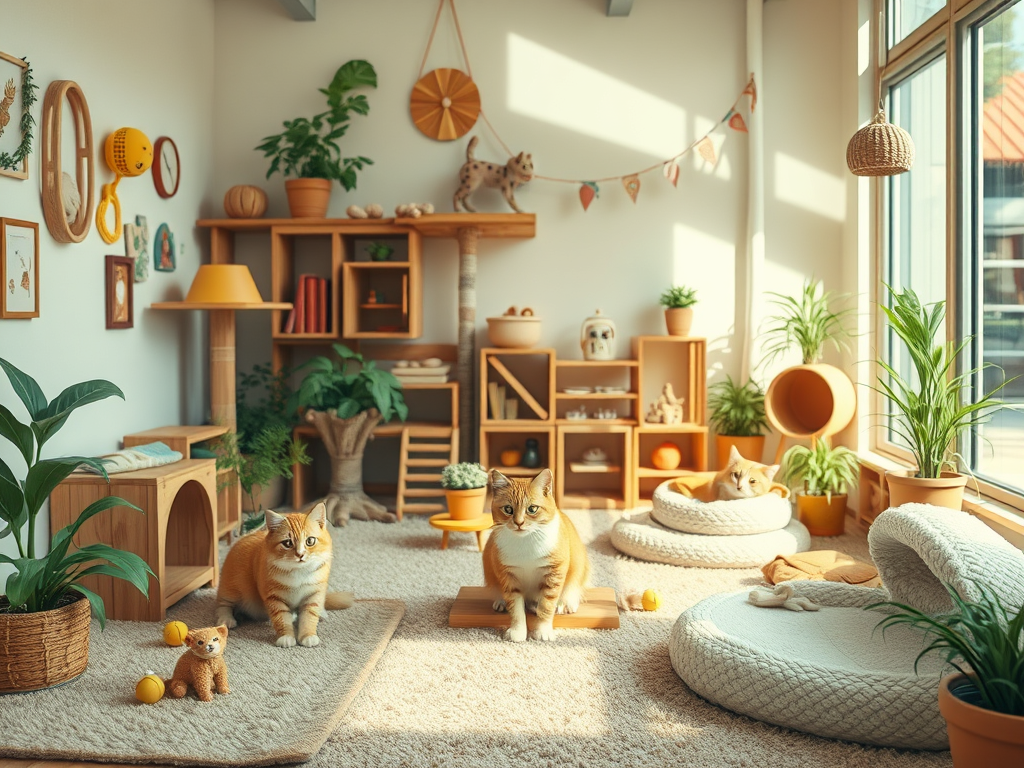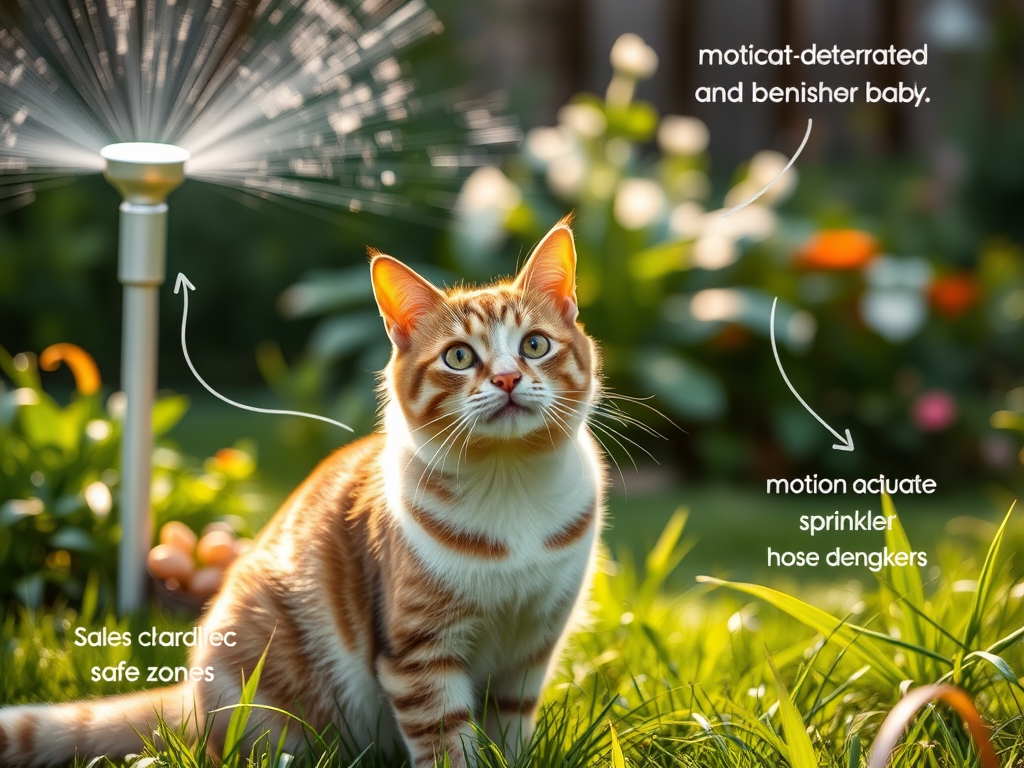Effective Strategies to Reduce Your Cat’s Hunting Behavior
Reducing Your Cat’s Hunting Impact on Wildlife: Cats are born hunters, a trait deeply embedded in their genetic makeup. While this instinct is natural, creating a secure indoor habitat can satisfy their hunting urges while safeguarding local wildlife. By thoughtfully designing engaging spaces and activities that stimulate their senses and mimic their natural behaviors, you can ensure that your beloved feline remains active and happy without endangering unsuspecting creatures outside your home.
Incorporating interactive toys into your cat’s playtime can significantly enhance their indoor hunting experience. Options like feather wands, laser pointers, and battery-operated mice can captivate your cat for hours. These toys effectively simulate the hunting process, allowing your cat to stalk and pounce, thus providing crucial mental stimulation and physical exercise. Engaging with these toys not only keeps your cat entertained but also promotes their overall health by helping them release energy in a productive way.
Transform your living space into an exciting feline playground by designing obstacle courses that include various elements like boxes, tunnels, and shelves. This playful setup encourages exploration and physical activity, allowing your cat to jump, climb, and investigate different areas. Cats are inherently curious, and by offering varied environments to explore, you create an experience that mimics their wild instincts, making them feel as though they are on an exhilarating adventure in their own indoor safari.
Never underestimate the benefits of puzzle feeders in your cat’s daily routine. These innovative feeding devices challenge your cat mentally while imitating the effort they would naturally exert while hunting. By integrating treat-dispensing puzzles into their mealtime, you can keep your cat’s mind sharp while providing a fun and rewarding experience. This method not only keeps your pet entertained but also encourages healthier eating habits as they learn to work for their food and treats.
Prioritizing playtime in your home is essential for both your cat’s happiness and your relationship. Engaging in social interaction through playtime is vital for strengthening the bond between you and your feline companion. Make it a routine to set aside specific times for play sessions, using the same engaging toys they enjoy during their solo activities. This shared play not only relieves any pent-up energy your cat may have but also deepens your emotional connection, making playtime an enriching experience for both of you.
Creating a lively indoor environment for your cat is achievable with some creativity and commitment. Your home can evolve beyond just a place of shelter; it can become an adventurous landscape that fulfills their natural hunting instincts while keeping them safe from outdoor dangers. With careful planning and thoughtful adjustments, you can cultivate a happy and fulfilled indoor cat.

Leash Training: Expanding Your Cat’s Horizons Safely
Embracing leash training can unlock exciting opportunities for safe outdoor exploration for your cat. While walking is often associated with dogs, cats can also experience the joys of the great outdoors with the right training and patience. By introducing your feline friend to a harness and leash, you can allow them to experience the beauty of nature while ensuring their safety.
Start your leash training journey with a properly fitting harness that provides comfort for your cat. It’s crucial to let your pet familiarize themselves with the harness before attempting to put it on. Allow them to sniff and explore the harness to reduce any anxiety they might experience. Gradually introducing the harness at their pace will help foster positive associations, making the entire process much smoother.
Once your cat is comfortable wearing the harness, attach a lightweight leash and practice walking indoors. This familiar setting will help them adjust to the leash while building confidence. Be patient, as some initial resistance is normal; taking your time will help your cat acclimate to this new experience calmly.
When you’re ready for outdoor adventures, choose a quiet and secure area like your backyard or a peaceful park. Ensure the location has minimal distractions and traffic to help your cat feel safe. Start with short outdoor sessions to avoid overwhelming your pet, gradually extending the duration as they become more relaxed exploring their new surroundings.
Supervised outdoor time enriches your cat’s life by allowing them to enjoy the various sights, sounds, and scents of nature without posing a risk to local wildlife. Picture the joy on your cat’s face as they encounter new experiences in a secure environment. This bonding experience not only enhances their quality of life but also fortifies your relationship.
Real-life stories from fellow cat owners can serve as motivation. Many have shared their initial concerns about whether their cats would adapt to leash walking, but consistency and positive reinforcement have proved invaluable. Celebrate each small success as you work towards broadening your cat’s experiences while ensuring their safety.
By integrating leash training into your cat’s routine, you’re promoting a balance between outdoor enjoyment and wildlife protection. This approach allows your cat to explore freely while fostering a sense of security in their environment.
Creating Safe Outdoor Spaces: How Catios Benefit Cats and Wildlife
Outdoor cat enclosures, commonly known as catios, provide an excellent solution for adventurous cats longing for outdoor experiences without the associated dangers. These secure spaces allow your feline friends to relish the outdoors while ensuring their safety and protecting local wildlife from potential threats.
Building or purchasing a catio can be customized to meet your space and budget requirements. Options can range from simple balcony enclosures to elaborate backyard structures. The key focus should be on creating an escape-proof environment, as safety is paramount when providing a secure haven for your cat.
When designing your catio, think about incorporating multiple levels and cozy hiding spots. Cats thrive in environments that offer vertical spaces and places to retreat. Adding platforms, ramps, and hammocks can transform a basic enclosure into a stimulating paradise, closely mimicking their natural habitat and promoting healthy exploration.
Enhancing sensory experiences within the catio can also significantly benefit your cat. Incorporate elements such as cat grass, scratching posts, or logs to create an engaging environment filled with appealing textures and scents. This sensory enrichment will keep your cat entertained and fulfilled while allowing them to enjoy the great outdoors in a controlled setting.
Regular maintenance is vital for ensuring the safety of your catio. Frequently check for any signs of wear and tear, including the integrity of the mesh, the structure, and locks. Cats are naturally curious and may test the limits of their enclosure, so keeping it in pristine condition is crucial for their safety and well-being.
With a catio, your feline companion can bask in the sun, climb, and observe wildlife without endangering local ecosystems. They can enjoy watching birds and other creatures from the safety of their outdoor sanctuary, remaining content while wildlife remains protected.

Proven Behavioral Training Techniques to Curb Hunting Instincts
Training your cat to minimize their hunting behaviors may appear daunting, but with the right techniques, it can be a manageable and rewarding task. The first step is to understand their natural instincts and the behaviors that drive them to hunt, which is essential for implementing effective training strategies.
Utilizing technology can significantly support your training efforts. Consider employing motion-activated deterrents, such as sprinklers or noise-makers, to establish boundaries that discourage hunting without interfering with other activities. Strategically zoning your yard into safe areas can redirect your cat’s focus away from potential prey.
Positive reinforcement plays a critical role in modifying your cat’s behavior. Reward them for non-hunting actions with treats or affection. For example, if your cat responds to your call or resists the urge to chase a potential target, reward them with a tasty treat or extra cuddles. This method encourages them to repeat desirable behaviors while diminishing their instinctive urge to hunt.
Incorporating clicker training can also be an effective method in your behavioral training toolkit. This technique involves associating a distinct sound with positive actions, allowing your cat to understand the connection between their behavior and the rewards they receive. By clicking at the moment they demonstrate desired behavior, you can reinforce good habits and clarify your expectations.
For more personalized assistance, consider consulting with feline behavior specialists. They can offer tailored advice and insights that address your cat’s specific challenges, helping you and your pet coexist harmoniously while respecting the local wildlife.
The objective of deterrents and training is not to punish but to guide your cat towards behaviors that prioritize their safety and the welfare of the environment. With consistency and patience, you can channel their instincts in a way that leads to safer outdoor interactions for both your cat and local wildlife.
Nutritional Feeding Strategies to Reduce Hunting Instincts in Cats
The type of food you provide and the methods you use can significantly impact your cat’s hunting instincts. Interestingly, a well-fed cat may still engage in hunting behaviors; however, the way you feed them can help mitigate this drive. Understanding the relationship between their diet and instinctual behaviors is essential for effective management.
Free feeding, where food is available throughout the day, may not be the best approach for every cat. Instead, consider establishing set feeding times. By creating a routine with predictable mealtimes, your cat may be less motivated to hunt since they learn to associate food with specific times of the day, thereby reducing their need to seek out prey.
Implementing interactive feeding strategies can transform your cat’s behavior for the better. Utilizing food puzzles or dispensers can replicate the hunting experience, requiring your cat to ‘work’ for their meals. This not only keeps them mentally sharp and physically active but also channels their energy into positive activities, allowing their natural instincts to be expressed safely.
Pay attention to the nutritional quality of their food as well. A diet high in protein and low in carbohydrates aligns more closely with a cat’s natural dietary needs, potentially leading to a reduction in hunting behaviors. Collaborating with a veterinarian to customize your cat’s diet can help ensure their nutritional requirements are met effectively.
Lastly, providing a variety of food types can satisfy their inherent curiosity and appetite for novelty. Switching between dry kibble, wet food, and raw diets can keep mealtimes exciting, reducing the temptation for your cat to seek thrills outside their food dish.
Implementing thoughtful feeding strategies goes beyond just providing sustenance; they can be a powerful tool for managing your cat’s behavior. By adjusting how and what you feed them, you can effectively reduce their inclination to hunt while keeping them healthy and satisfied.

Encouraging Community Responsibility for Cat Conservation
Cats are beloved companions, and as their guardians, we have a responsibility to ensure they coexist harmoniously with local wildlife. By embracing community initiatives and personal accountability, we can significantly reduce the ecological impact of free-roaming cats on wildlife populations.
Engaging with local conservation groups is an excellent way to stay informed about wildlife-friendly practices. Many communities offer educational workshops for cat owners that address the ecological consequences of allowing cats to roam freely, providing solutions to mitigate these effects.
Consider initiating or participating in neighborhood discussions or social media groups centered around responsible pet ownership. Sharing resources, tips, and personal experiences can help cultivate a wildlife-conscious community, creating a supportive environment for all pet owners.
A proactive approach could involve establishing cat-friendly zones within community gardens or parks. These designated areas can include enclosures or supervised play spaces, ensuring a safe environment for both cats and wildlife. This collaborative effort promotes awareness and encourages positive interactions between pets and nature.
Incorporating family-oriented initiatives, such as sticker campaigns or educational contests for children and teens, can raise awareness about responsible pet ownership and the importance of coexisting with nature in a respectful manner.
Lead by example at home by implementing the strategies you’ve learned. Whether it’s leash training, building catios, or adjusting feeding practices, demonstrating your commitment to a harmonious relationship between your cat and the environment can inspire others to do the same.
By merging individual actions with community-focused initiatives, we can create a supportive network that balances our cats’ needs with ecological stewardship. Together, we can cherish our pets while respecting and protecting the natural spaces around us.
The Article: Minimize Your Cat’s Hunting Impact Appeared First On Unity Pets.
The Article Minimize Hunting Impact of Your Cat Effectively Was Found On https://limitsofstrategy.com

